The Purple Gang: Bootlegger’s Paradise — Bootlegger’s Paradise — Crime Library
The Detroit River, representing the border between Ontario, Canada and the United States, is one of the busiest waterways in the world, with freighters bringing iron ore from Michigan’s Upper Peninsula to the bustling automobile factories of the Motor City. Timber barges from northern Michigan and Wisconsin pass through the narrow waterway which separates Windsor, Canada and Detroit, Michigan en route to Lake Erie and the East Coast and hordes of recreational boaters and weekend fishermen use the river for their pleasure.
In the winter, traffic on the narrow flow (less than a mile across in some places) comes to a halt as the river freezes over.
During Prohibition, rumrunners and bootleggers used the frozen river as an easy way to get booze from Canada into the United States. From Detroit liquor went to Chicago (where Capone sold it under his “Log Cabin” label), St. Louis, and points west.
It was a well-known fact that if you were bringing a load of hooch across the Detroit River that you had better show up armed to the teeth. Because in the 1920s, Detroit belonged to the Purple Gang, a group of killers and thugs as vicious and bloodthirsty as any racketeer in New York or Chicago.
The Purples ran the rackets in Detroit for much of the 1920s and early 30s until the Syndicate boys from back east moved in and wrested control from a gang that had seen its numbers decimated by infighting and prosecution.
Detroit may not have been New York, but make no mistake: the Purple Gang was tough. They were strong enough to tell Capone to keep his mitts off eastern Michigan and managed to hold on to control of most of the state when Scarface was at his peak (U.S. 31, which cuts the gut of Grand Rapids and runs from the top of the mitten to the Indiana border was the territorial line. West of 31 was Capone’s territory but east belonged to the Purples). Capone coveted Detroit, with its huge number of hardworking, hard-drinking laborers, but wisely decided it was better to buy booze from the Purple Gang than to fight them.
Bootleggers in Detroit had a jumpstart on much of the nation, when Michigan passed a state prohibition on liquor in 1916 effective the next year. Henry Ford, whose River Rouge plant employed more than 100,000 people at its peak, was a leading proponent of a sober workforce. His workers, however, had other ideas.
What Ford and the other teetotalers didn’t take into account was the city’s close proximity to borders with Ohio and Canada. When Prohibition went into effect in Michigan with the passage of the Damon Act in 1917, the spigots on illegal booze were turned on. Anyone with a boat could get to Canada and friendly Toledo, less than 60 miles south of Detroit, was more than willing to meet the needs of thirsty Detroiters.
“False floorboards in automobiles, second gas tanks, hidden compartments, even false bottomed shopping baskets and suitcases, not to mention camouflaged flasks and hot water bottles were all employed as the entrepreneurial and the thirsty navigated the Dixie Highway between Detroit and the Ohio border,” wrote Jenny Nolan in The Detroit News. “It was a sort of dress rehearsal of ingenuity and audacity for the much larger operations to come.”
Judges took a lenient view of offenders, and in 1919 the Damon Act was declared unconstitutional. Traffic between Michigan and Ohio returned to normal and for a short time the tables were turned as Ohio outlawed the manufacture and sale of liquor.
But anti-liquor fever ran high in those days. When the Volstead Act became law in 1920 and Prohibition was the law of the land, rumrunners in Detroit were ready.
Canada replaced Ohio as the favorite travel spot for Detroiters. Although Ontario had outlawed the retail sale of liquor, the federal government approved and licensed distilleries and breweries of which there were 45 in Ontario alone in 1920 to manufacture, distribute, and export.
“With the Detroit River less than a mile across in some places, and 28 miles long with thousands of coves and hiding places along the shore and among the islands, it was a smugglers dream,” wrote Nolan. “Along with Lake St. Clair and the St. Clair River, these waterways carried 75 percent of the liquor supplied to the United States during Prohibition.”
Cargo was towed beneath boats, old underground tunnels were built, sunken houseboats hid underwater cable delivery systems, and even a pipeline was built. Between Peche Island and the foot of Alter Road, an electronically controlled cable hauled metal cylinders filled with up to 50 gallons of booze. A pipeline was constructed between a distillery in Windsor and a Detroit bottler.
Illegal liquor was the second biggest business in Detroit at $215 million a year in 1929, just behind automobiles. During Prohibition, the trade in alcohol employed about 50,000 people in the Detroit area, according to The Detroit Free Press. There were as many as 25,000 blind pigs operating in the Detroit area, and authorities were not only helpless to stop it, many were part of the problem.
Nick Schaefer ran a blind pig across the street from Police Headquarters, above a bail bondsman’s office. Reporters and police alike frequented the place for its famous potato soup and free lunch.
When the state police raided the Deutsches Haus at Mack and Maxwell, they arrested Detroit Mayor John Smith, Michigan Congressman Robert Clancy and Sheriff Edward Stein. From St. Clair Shores’ Blossom Heath on Jefferson to Little Harry’s downtown, to the Green Lantern Club in Ecorse, Detroit’s most upstanding citizens fed the coffers of the gangs that were reaping huge fortunes from their appetite for alcohol.
With such a demand for booze, it wasn’t long before organized groups took over from informal rumrunners. The Licavolis, Bommaritos, Lucidos and Zerillis brought a Sicilian flavor to east side efforts, while the Tallman gang led the West Side.
The one group who had the run of the town was the Purple Gang.
Like most other big cities around the turn of the century, Detroit’s ghettos were a breeding ground for crime and violence. The Purple Gang’s evolution isn’t much different from a dozen similar stories from any American city. They were really no different than the Five Points Gang in Brooklyn, the Northside Gang in Chicago or the Boiler Gang in Philly.
Rumor had it that the gang received its colorful name as the result of a conversation between two Hastings Street shopkeepers of the era. Both of the men’s shops had been the target of the youngsters’ shoplifting and vandalism forays. One day in disgust one of the shopkeepers exclaimed, “These boys are not like other children of their age, they’re tainted, off color.”
“Yes,” replied the other shopkeeper. “They’re rotten, purple like the color of bad meat, they’re a Purple Gang.”
In the beginning, the “gangsters” were nothing more than the sons of Russian Jewish immigrants who had come to the New Country in search of a better life. But like so many others, the immigrants found life in the United States wasn’t that different and that the streets really weren’t paved with gold.
The Purples, growing up in almost unimaginable poverty, began to prey on their fellow immigrants.
“The boys snatched ice cream, gum, candy, cookies and fruit from hucksters and stores,” wrote one Detroit Free Press writer at the time. “They ganged up on children their own age, sometimes they strong-armed grownups.”
The boys, led by the four Bernstein brothers Abe, Joe, Raymond and Izzy, were shakedown artists and jewel thieves, but thanks to Prohibition and the convenient location of Detroit, the young delinquents quickly graduated from nuisance types of street crime to armed robbery, hijacking, extortion, and other strong arm work. They became notorious for their high profile manner of operation and their savagery in dealing with enemies.
By the early twenties, the Purples had developed an unsavory reputation as hijackers, stealing liquor loads from older and more established gangs of rumrunners.

“The Purple Gang always preferred hijacking to rumrunning and their methods were brutal, wrote Paul Kavieff in his book on the gang, Off Color. “Anyone landing liquor along the Detroit waterfront had to be armed and prepared to fight to the death as it was common practice for the Purples to take a load of liquor and shoot whoever was with it. In the early years, the Purple Gang preyed exclusively on other underworld operators, insulating them from the police.”
The young Purple Gangsters attracted the attention Charlie Leiter and Henry Schorr, two Mustache Petes who operated the Oakland Sugar House on Oakland Avenue. Leiter and Schorr used the Bernsteins and their compatriots like George F. Lewis, Abe Axler and Eddie Fletcher for strong-arm work extorting businesses and leaning on back-alley brewers.
Inspector Henry J. Garvin, head of the Detroit crime and bomb squad, called the Purple Gang the ruler of the city’s underworld through terrorism. The Purple Gang of 1928, however, was not wholly composed of the “off-color” gang of the Hastings street hoodlums of 1918. The new group had been in existence only two years. But its leaders, Inspector Garvin declared, were the same boys who ruled the gang that plagued the ghetto merchants and hucksters.
In its rank and file were recruits from New York, St. Louis and Chicago. It was organized in 1926, Garvin said, as a defensive measure against the “St. Louis Gang,” which had invaded Detroit shortly before the kidnapping, in March 1926, of Meyer “Fish” Bloomfield, a stickman at the Grand River Athletic Club, Charles T. “Doc” Brady’s casino. Doc Brady paid fifty grand for the return of his employee. This was the first of a long series of kidnappings of gambling house operators for ransom.
The first act laid against the new Purple Gang was the triple slaying in the Milaflores Apartments, in March 1926, when Frankie Wright, Reuben Cohen and Joseph Bloom were killed by machine gun fire in an apartment occupied by Axler and Fletcher. Fred “Killer” Burke, famous for his role in the St. Valentine’s Day Massacre in Chicago in 1929, was hired by the Purples as the machine gunner.
Wright, Bloom and Cohen were gunned down as they waited to enter the Axler-Fletcher apartment, where they had been invited to a “peace conference.” The St. Louis gunsels were slain, it was reported at the time, because of a double-cross laid on the Purple Gang in the kidnapping of Fish Bloomfield. Although arrests were made, no one was ever convicted of the Milaflores slayings.
In the killings, the Purples became the first criminals in Detroit to use Thompson submachine guns. After they mowed down their three rivals, newspaper reporters counted 110 bullet holes.
As the gang grew in size and influence, they began to hire themselves out as mercenaries, taking part in the Cleaners and Dyers War, keeping union members in line and harassing non-union independents. Bombings, thefts, beatings, and murder were all methods employed by the Purples to enforce union policy. They were paid handsomely for their services.
Virtually all the bombing outrages in that warfare were ascribed to the gang by the police.
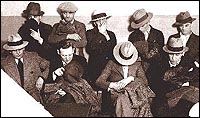
& Dryers War
In 1928, Charles C. Jacoby, vice-president of Jacoby’s French Cleaner’s & Dyers, Inc., and nine alleged members of the Purple Gang, were arrested and charged with conspiracy to extort money from Detroit wholesale Cleaners & Dyers. Besides Jacoby, the defendants included Abe Bernstein, Raymond Bernstein, Irving Milberg, Eddie Fletcher, Joe Miller, Irving Shapiro, Abe Kaminsty, Abe Axler and Simon Axler.
When the police concentrated their efforts on the Purple Gang, shutting off its source of revenue, it formed an alliance with the Oakland Sugar House Gang which had engaged in bloody warfare with other gangsters over tribute from distillers and bootleggers and others associated with the liquor racket.
The Purples ordered the Sugar House Gang to raise money for their defense fund by putting a tax of 55 cents on every 100 pounds of sugar sold to distillers. Other merchants were terrorized into paying tribute when the sugar tax did not raise enough revenue. Then the police raided the Sugar House Gang. Joseph Bernstein, brother of Abe Bernstein, alleged leader of the Purple Gang, was one of those arrested.
In explaining why the police had been unable to break up the Purples, Garvin said that the gangsters preyed only on racketeers and had the underworld so terrorized that no one dared to “squawk.” Hence, he said, the police were unable to get anyone to sign a complaint against them.
Taking of testimony in the extortion trial relating to the Cleaner and Dyer wars started before Judge Charles Bowles and a Recorder’s Court jury June 4, 1928. The State called 42 witnesses. A month’s adjournment was necessitated by the illness of Judge Bowles. Early in September, 1928, the case came to an end when the jury acquitted Jacoby and the alleged gangsters. Then Frank X. Martel, president of the Detroit Federation of Labor, was charged with extorting money from the Jacobys, and he, too was acquitted.
An acquittal wasn’t surprising in the case. After all, “someone” had broken into the Cleaners and Dyers Union offices shortly before the trial and stolen the documents that could have proved the extortion case. No arrests were made in the break-in.
“Also to members of the gang the police ascribed the deaths of Sam Sigman, of the Perfect Cleaners and Dyers, two and a half years ago, and of Sam Polakoff, of the Union Cleaners and Dyers, whose bullet-riddled body was found one morning at Dexter Boulevard and Grand Avenue a little more than a year ago,” according to a 1929 Detroit News article about the gang.
Police also blamed the gang for the slaying of Patrolman Vivian Welsh, “who was taken for a ride.”
“Welsh according to the Homicide Squad, had been ‘shaking down’ blind pig owners and in doing so had unwittingly invaded the field of the Purple Gang,” the News wrote.
During the late twenties, the Purple Gang reigned supreme over the Detroit underworld, controlling the city’s vice, gambling, liquor, and drug trade. They also controlled the local wire service which provided horse-racing information to all of the Detroit horse betting parlors and handbooks.
The gang members, now at the top of the food chain in the Motor City, cavorted with some more infamous mobsters, branching out into other cities, as well. Abe Bernstein was a friend of Meyer Lansky and Joey Adonis, with whom he owned several Miami gambling casinos. Bernstein also did a big favor for Capone.
On February 13, 1929, Bernstein called Bugs Moran and told him a hijacked load of booze was on its way to Chicago.
Moran, who was in the middle of a turf war with Capone, had only recently begun to trust Bernstein, who had previously been Capone’s chief supplier of Canadian liquor.
The two hoods agreed on a price of $57 a case, according to Jay Robert Nash in his book Bloodletters and Bad Men.
“Deliver it to the garage,” Bugs told Bernstein. “All the boys will be here. We’re short and they’ll want a cut.”
The next day, instead of delivering a load of liquor, five men dressed as cops went to S.M.C. Cartage on North Clark Street Bugs’ Northside hangout and opened fire with machine guns, killing seven men in what has become known as the St. Valentine’s Day Massacre.
The Purple Gang
The Collingwood Manor Massacre
The beginning of the end for the Purple Gang came as Detroit prepared for an upcoming national convention of the American Legion. Stressed bootleggers struggled to keep up with demand for booze and tempers wore thin as rival gangs hijacked and re-hijacked shipments of alcohol. A bookmaking operation that couldn’t cover its bets, a crackdown by federal agents and a long-time feud between the Purple Gang and some out-of-town upstarts who wouldn’t follow orders set the stage for a showdown that is unmatched in the history of Detroit for its ferocity.
In a killing that would the shock city and result in banner headlines for weeks in the three Detroit newspapers, some hard-line Purple gangsters settled an old score but set themselves up for a fall that would signal the end of the gang’s influence in Detroit rackets.
Hymie Paul, Joe “Nigger Joe” Lebowitz, both 31, and 28-year-old Joe “Izzy” Sutker were brought to Detroit by Leiter and Schorr’s Oakland Sugar House Gang as “rod men” to protect the mobs lucrative alcohol supply racket.
But the three men weren’t interested in being someone else’s gunsels and they soon decided to branch out on their own. Paul, Lebowitz (a.k.a. Liebold), and Sutker (a.k.a. Sutton) chose the racetrack handbook racket and the wholesale liquor business.
The trio did their job well, associating with the Third Avenue Navy, a gang which earned its moniker because it landed its cargoes of Canadian whiskey in the railroad yards between Detroit’s Third and Fourth Avenues. But the men disregarded the strict code of Detroit’s underworld. They hijacked from friends and enemies and double-crossed business partners. They refused to stay within their own boundaries and stepped on the toes of neighboring gangs.
They were known as “the Terrors of the Third street district,” according to police Inspector Frank Fraley, who had sparred with the gang. Fraley evicted the boys from the Orlando Hotel after he received complaints that the gang was using rooms there as an office.
“I told them we did not want them in our precinct and to get out,” he told the Detroit Times.
In the spring of 1931, the trio’s bookmaking operation was gearing up. They had taken in a local hood, Solomon “Solly” Levine and everything was looking good for the boys until the East Side Mafia, which had been giving their book some serious play hit a big parlay worth a couple hundred grand.
It was money the gang didn’t have. In fact, they were broke. Sutker, his wife Doris and their 5-year-old daughter had recently been evicted from their apartment for non-payment of rent and the boys had lost their “large, high-powered cars” because they were unable to keep up the payments.
The trio, afraid of reprisals if they welshed on the bet, bought some booze from the Purples on credit, diluted it and undersold the market for a quick profit.
“The east side gang came back again with another ‘boat race,” a fixed horse race, taking the handbook for even more money,” wrote Joe Wolff, a Detroit News writer, in 1971. “Again a deal was made with the Purple Gang to get 50 gallons on credit. Again they diluted the stock and undersold the market price.
“They had pushed their luck. Their activities spelled death; it was just a matter of time and which gang would move to stop them first.”
Autumn 1931 was a busy time for bootleggers in Detroit. The American Legion convention was coming to town and huge orders for illicit booze had been placed by the various blind pigs, cabarets and speakeasies around the city.
The three partners knew that they were in deep and felt that they could make it up when the Legionnaires came to town.
“They owed (Ray) Bernstein some money for whiskey and they wanted to get him to hold off until after the legion convention,” Solly Levine told the Detroit News the day after the fates caught up with the trio. Bernstein said he would get in touch and that something would be worked out.
“We’ve got everything straightened out and we’re going to let you boys handle the horse bets and alcohol when you straighten out that bill,” Bernstein, slim, a blue-eyed, man with a perpetual scowl, told Levine.
Levine was the perfect go-between for the rivals. He was a partner in the bookmaking operation and had a long-time acquaintance with many of the Purple Gang, growing up in the same neighborhood as the Bernstein brothers.
A peace conference sounded good to the three partners and they relaxed a bit, thinking that they were back on the way to Easy Street.
That night, Izzy Sutker sent a couple of his henchmen to Port Huron to pick up his 18-year-old girlfriend, Virginia White. The two of them spent the night at a cabaret near the bookie joint drinking and listening to a band.
Hymie Paul went to bed early, secure in the fact that a meeting would be held to set things right.
Lebowitz was also feeling cocky and spent a rousing night on the town, waking up the next morning with a hangover so bad he didn’t bother to shave.
On September 16, Levine was working at the bookie joint when one of the Purples called him with an address for the meeting: 1740 Collingwood, Apartment 211. Be there at 3 p.m. Levine wrote the information down on one of the book’s pink betting slips.
That afternoon, the four men left the book about 2:45 p.m. unarmed it wouldn’t look good to go to a peace conference armed, after all.
Right on schedule the four men arrived at the Collingwood address, a quiet residential section on the city’s West Side.
Ray Bernstein met the men at the door of the apartment. As they entered the apartment, one of the other men turned off a phonograph, leaving the needle in the middle of the record.
“Ray said he was glad to see us,” Levine said later. “(Irving) Milberg and (Harry) Keywell were there too and so was Harry Fleisher.”
The baby-faced Keywell was a tough customer whose innocent looks belied a hard interior. He had been accused but acquitted of illegal possession of firearms and assault with intent to do great bodily harm earlier in the year. Keywell was also named as a suspect in the St. Valentine’s Day Massacre.
It was a surprise to see Fleisher, because the feds were looking for him and the word on the street was that he had taken it on the lam. Fleisher, 29, was a slightly built killer whose rapsheet listed such crimes as assault with intent to kill, armed robbery, kidnapping and receiving stolen property.
Milberg’s record spanned more than a decade and included everything from armed robbery to disturbing the peace. He was known as a crack shot.
After the rival gangsters exchanged greetings, Paul, Levine and Lebowitz sat next to each other on a couch and Izzy took a seat on the arm. They chatted amicably for a few minutes.
Fleisher looked at Bernstein and asked, “where is that guy with the books?” referring to their accountant. Bernstein said something about going to look for him and left the apartment. Bernstein went down to the street where the Purples had a car waiting. He started the engine, raced the engine loud enough to irritate several neighbors nearby and laid on the horn.
“That was the signal,” Levine recalled. “Fleisher pulled out his gun and fired at Nigger Joe and the bullet went right by my nose.”
At the same time, Milberg and Keywell fired at Sutker and Hymie Paul.
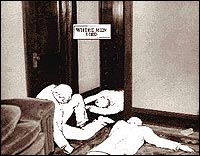
et al.
The hail of gunfire had caught the trio by surprise, but it was apparent from the positions of their bodies that they had tried to get away. Paul lay slumped against the couch in the living room with eight bullets in his back and head a cigar still clenched in his hand, Lebowitz was sprawled in a short corridor leading to the bedroom, a battered cigar stub in his teeth. Izzy Sutker died in the bedroom of the apartment, two bullet holes not more than an inch apart in his forehead, a stogie in his hand.
The three young hoodlums fell far short of their goal of making it big in the rackets. Izzy had 11 cents on him, Hymie had $2, and Lebowitz died with $92 in his pocket.
Fleisher turned to Levine, who was astounded that he was still alive, and asked “You OK?” Levine nodded mutely, waiting for his execution.
The three killers huddled for a moment and then turned to Levine. “Let’s go,” one of them shouted. The four men ran to the kitchen, where Fleisher, Milberg (whose sharpshooting had dropped Izzy) and Keywell, a murderer who had yet to attain voting age, dropped their .38 caliber revolvers into a bucket of green paint.
The paint destroyed any chance the cops had of pulling fingerprints from the pistols. The killers had taken pains to cover their tracks; they had filed the serial numbers from the Colts, as well.
Levine, Milberg and Keywell joined Bernstein in the big, black 1930 Chrysler. Fleisher arrived a few moments later after the men heard more shots from the apartment.
“Nigger Joe was still living a bit,” he told them.
A young mother, trying to put her baby down for a nap heard the commotion and rushed out into the hall, encountering Fleisher on his way to the car.
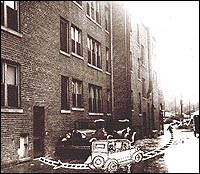
“The man was taking the steps two at a time toward the alley,” she told the Detroit Times.
The Chrysler sped out of the alleyway behind the Collingwood apartment, nearly running over a small boy playing in the street and the sister of a Detroit Probate Court judge.
“They shot away so fast the driver burned his tires on the alley pavement,” said apartment caretaker Harry McDonald, who witnessed the escape. “Walking to the car the men moved quickly but they did not seem excited.”
The killers “drove like the devil” for a few blocks, Levine said. Then they split up.
“Bernstein shook hands with me and said, ‘I’m your pal, Solly.’ He gave me three or four hundred dollars and said go back to the book and he’d pick me up later.”
Solly Levine did go back to the book, unaware that the Purples weren’t done with him. Bernstein planned to take him for a ride later and frame him for the murders.
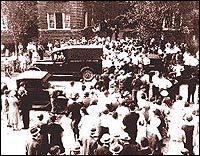
Manor apartments
But the heat came down fast after the killings and inside an hour Levine was in police custody.
He told police that he and the three dead men had been kidnapped while on their way to talk to well-known Detroit bootlegger Harry Klein, owner of a local deli and friend of the Purple Gang.
“I give you my word,” Levine told the Times. “I didn’t see anyone.”
Police quickly discounted Levine’s kidnapping story after he failed to tell the tale the same way twice.
Lawmen quickly set up a dragnet to find the killers, and Wayne County Prosecutor Harry S. Toy told reporters he wanted to find the gunmen “dead or alive.”
Toy issued orders for the roundup of all Purples and reportedly ignored overtures from Purple chiefs who said they were willing to surrender.
“There will be no deals,” he said. “We’ll go and get them.”
One of the first people arrested in connection with the murders was Klein, who was carrying one of the dead men’s markers. Klein denied knowing anything of the crime or of a planned meeting with Izzy Sutker and was eventually freed.
The heavy police dragnet yielded results in less than 48 hours.
“We got scores of telephone calls giving us valuable information as soon as we released the names of the killers,” Toy said.
The tips likely came from enemies of the Purple Gang, with the underworld leaping to take advantage of an opportunity to rid itself of their domination.
Acting on an anonymous tip, heavily armed police surrounded an apartment owned by Charlie “The Professor” Auerbach, who listed his occupation as jewelry salesman. Inside, Ray Bernstein and Harry Keywell were holed up with Auerbach, his wife and an 18-year-old cabaret entertainer named Elsie Carroll. The Detroit Times identified her as “a smartly dressed, flip-cracking blonde, said to be the sweetheart of Izzy Bernstein.”
The women were carrying more than $9,000 in cash and police found tear gas and guns in the house.
The gangsters were reportedly quite sullen when they were brought into police headquarters.
“Ray Bernstein’s snarl and swagger left him,” the Detroit Times wrote. “Detectives said he appeared nervous.”
The next day, Irving Milberg, whose receding hairline belied his years, joined his gang behind bars when authorities staged a raid on Milberg’s flat on West Chicago Boulevard. While they were there, Milberg’s wife, Mildred, called the house, where a maid was watching her children. The call was traced to Purple Gang gunman Eddie Fletcher’s apartment three blocks away.
When authorities burst into Fletcher’s apartment they found Abe Axler, Milberg and Eddie Fletcher playing cards, a packed suitcase in Axler’s car and five pistols and a rifle at the ready. The men surrendered without a fight, although Milberg tried to escape by flinging open a window and punching out a screen.
The killers were in custody.

& Keywell
The gunmen were quickly bound over and a little over a month after the massacre, in a packed courtroom, Milberg, Ray Bernstein and Keywell were put on trial.
The Purples spared no expense in trying to save their members. The defendants’ cronies reportedly were squeezing money from local bookmaking operations, who were compelled to contribute $2 per day for “betting service.”
Solly Levine remained the key witness for the prosecution and despite the best efforts of defense attorneys stuck with his story that the three men killed his friends.
Prosecutor Toy led the case himself, summarizing the case before the jury:
“I hold no brief for the victims and their occupation. This is no defense, however. These men checked their books with bullets and marked off their accounts with blood. They lured the victims to the apartment with promises of partnership and killed them when they were unarmed and helpless.”
After an hour-and-a-half of deliberations, the jury returned guilty verdicts against all three men.
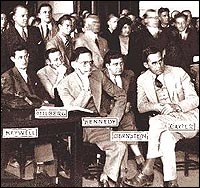
Kennedy and Baxter at the trial
The verdict caused an eruption in the courtroom. Friends and relatives of the killers screamed hysterically and court officers climbed on tables to restore order.
A week later, Judge Donald E. Van Zile sentenced the three to the mandatory life in prison without parole. Shortly afterward with little fanfare, Ray Bernstein, Irving Milberg and Harry Keywell boarded a special Pullman train bound for Michigan’s Upper Peninsula to begin serving their sentences in the state’s maximum security prison in Marquette.
Harry Fleisher remained on the lam until 1932, but he was never convicted in connection with the massacre. He did serve time in Alcatraz in the early 1950s for armed robbery of an Oakland County gambling house.
Milberg died in prison after serving seven years.
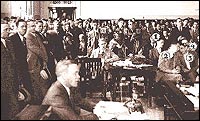
Gang trial
Harry Keywell had a spotless prison record for 34 years before his life sentence was commuted. He walked out of prison on October 21, 1965 and later married, obtained a job and faded into obscurity.
Ray Bernstein suffered a stroke in 1963 and was transferred to the state prison in Jackson. He was paralyzed in the left side and his speech was impaired when, wrapped in a blanket and in a wheelchair, he was brought before the parole board.
Bernstein, still denying his role in the massacre, was a model prisoner. He had no misconduct during his term and taught school to inmates after he received his own high school diploma. He also was known for giving financial assistance to other inmates.
The board gave him mercy parole in 1964 and he died two years later.
Solly Levine got a life sentence of another sort.
Fleeing the vengeance of the remaining Purple Gang members, Levine was put on a boat to France by police. However, when he landed in Le Havre, the government wouldn’t take him and sent him back. He then tried to go to Ireland, but couldn’t get a passport.
He then disappeared.
“It would be hard to tell whether or not Solly escaped successfully,” Judge Van Zile said in 1940.
Other members of the Purple Gang died as they had lived. Abe Axler and Eddie Fletcher were taken for a ride when Lucky Luciano’s East Coast Syndicate moved into the city. As the national crime syndicate began to consolidate the underworld in the mid 1930s, the remnants of the Purple Gang were absorbed.
The convictions in the Collingwood Massacre “broke the back of the once powerful Purple Gang, writing finis to more than five years of arrogance and terrorism.,” said Detroit Police Chief of Detectives James E. McCarty. “The effect of Bernstein’s conviction should be a great influence. He reached the top of the underworld and all it got him was a life sentence.”
